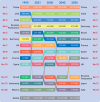Projections for prevalence of Parkinson's disease and its driving factors in 195 countries and territories to 2050: modelling study of Global Burden of Disease Study 2021
- PMID: 40044233
- PMCID: PMC11881235
- DOI: 10.1136/bmj-2024-080952
Projections for prevalence of Parkinson's disease and its driving factors in 195 countries and territories to 2050: modelling study of Global Burden of Disease Study 2021
Abstract
Objective: To predict the global, regional, and national prevalence of Parkinson's disease by age, sex, year, and Socio-demographic Index to 2050 and quantify the factors driving changes in Parkinson's disease cases.
Design: Modelling study.
Data source: Global Burden of Disease Study 2021.
Main outcome measures: Prevalent number, all age prevalence and age standardised prevalence of Parkinson's disease in 2050, and average annual percentage change of prevalence from 2021 to 2050; contribution of population ageing, population growth, and changes in prevalence to the growth in Parkinson's disease cases; population attributable fractions for modifiable factors.
Results: 25.2 (95% uncertainty interval 21.7 to 30.1) million people were projected to be living with Parkinson's disease worldwide in 2050, representing a 112% (95% uncertainty interval 71% to 152%) increase from 2021. Population ageing (89%) was predicted to be the primary contributor to the growth in cases from 2021 to 2050, followed by population growth (20%) and changes in prevalence (3%). The prevalence of Parkinson's disease was forecasted to be 267 (230 to 320) cases per 100 000 in 2050, indicating a significant increase of 76% (56% to 125%) from 2021, whereas the age standardised prevalence was predicted to be 216 (168 to 281) per 100 000, with an increase of 55% (50% to 60%) from 2021. Countries in the middle fifth of Socio-demographic Index were projected to have the highest percentage increase in the all age prevalence (144%, 87% to 183%) and age standardised prevalence (91%, 82% to 101%) of Parkinson's disease between 2021 and 2050. Among Global Burden of Disease regions, East Asia (10.9 (9.0 to 13.3) million) was projected to have the highest number of Parkinson's disease cases in 2050, with western Sub-Saharan Africa (292%, 266% to 362%) experiencing the most significant increase from 2021. The ≥80 years age group was projected to have the greatest increase in the number of Parkinson's disease cases (196%, 143% to 235%) from 2021 to 2050. The male-to-female ratios of age standardised prevalence of Parkinson's disease were projected to increase from 1.46 in 2021 to 1.64 in 2050 globally.
Conclusions: By 2050 Parkinson's disease will have become a greater public health challenge for patients, their families, care givers, communities, and society. The upward trend is expected to be more pronounced among countries with middle Socio-demographic Index, in the Global Burden of Disease East Asia region, and among men. This projection could serve as an aid in promoting health research, informing policy decisions, and allocating resources.
© Author(s) (or their employer(s)) 2019. Re-use permitted under CC BY-NC. No commercial re-use. See rights and permissions. Published by BMJ.
Conflict of interest statement
Competing interests: All authors have completed the ICMJE uniform disclosure form at www.icmje.org/disclosure-of-interest/ and declare: support from the National Nature Science Foundation of China; no financial relationships with any organisations that might have an interest in the submitted work in the previous three years; no other relationships or activities that could appear to have influenced the submitted work.
Figures









References
MeSH terms
LinkOut - more resources
Full Text Sources
Medical
